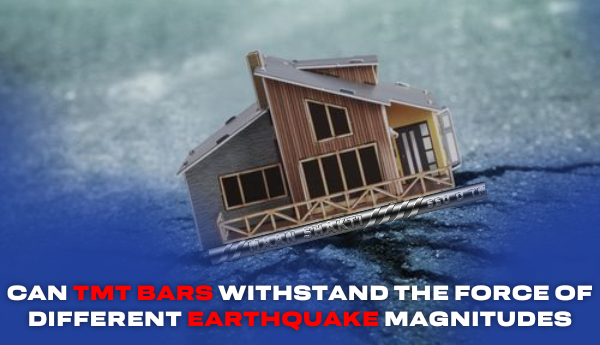When the earth decides to give you a shake, rattle, and roll, your building should stay put, right? You could be in the middle of a workday, sipping coffee, and suddenly the ground beneath your feet feels like it’s auditioning for a dance-off. That’s an earthquake for you. The only thing that could keep the structure stable might be the TMT bars at the base of the structure. But here’s a kicker— can the TMT bars holding up your building withstand that kind of power? In this blog, you will learn about earthquake-resistant TMT bars and find out how well they fare when tectonic plates start getting too close for comfort.
Understanding Earthquake Magnitudes
All earthquakes aren’t created equal. Some are minor, barely causing a ripple, while others leave buildings looking like a house of cards. Earthquake magnitude is measured on the Richter scale, with each number representing a tenfold increase in power. A 5.0 magnitude tremor might just give you a gentle nudge, but anything above 7.0? That’s when things get serious. So, how do buildings survive these natural ground tantrums? With a little help from TMT bars, of course!
What Makes A TMT Bar Earthquake-Resistant?
Now, let us talk about the real heroes— Thermo-Mechanically Treated (TMT) bars. These steel rods aren’t your ordinary pieces of metal. They are designed to be flexible, strong, and resilient—everything you want in a building material. So, what is special about TMT bars? It’s not magic— just meticulous engineering. These steel rods are put through a special treatment process, where they are rapidly cooled after being heated to extreme temperatures. This gives them that flexible inner core and tough outer surface that we’ve been raving about. This combination is crucial in seismic zones, where buildings need materials that can handle the unpredictable nature of an earthquake.
Additionally, the ribbed surface of TMT bars ensures a stronger bond with concrete, further enhancing the structure’s overall integrity during a quake. So, it’s safe to say that choosing earthquake-resistant TMT bars is like giving your building a safety net against nature’s ground-shaking temper tantrums.
How Do TMT Bars Stand Against Different Earthquake Magnitudes?
Minor Tremors (Magnitude 4.0-5.0)
In the grand scheme of earthquakes, a 4.0-5.0 tremor is like a warm-up before the main event. You’ll feel it, but it’s unlikely to cause significant damage. TMT bars in buildings exposed to minor tremors typically flex and absorb the energy. Their ductility, which allows them to bend without breaking, ensures that the structure stays intact even if the ground decides to move.
Moderate Shakes (Magnitude 5.0-6.0)
When the Richter scale starts to hover around 5.0-6.0, things start to get interesting. These moderate quakes can cause walls to crack and weaker structures to falter. But here’s where leading TMT bar producers come into play. They design bars with high ductility, ensuring that buildings can sway and move with the quake rather than resist it rigidly. TMT bars allow for just the right amount of movement, protecting your structure without snapping under pressure.
Strong Quakes (Magnitude 6.0-7.0)
Earthquakes in the 6.0-7.0 range are no joke. They can leave buildings in shambles if they aren’t up to code. Luckily, TMT bars are designed for this kind of challenge. Thanks to their mix of tensile strength and elongation properties, these bars can absorb a significant amount of seismic energy. The idea is simple: let the bars bend and stretch, allowing the building to ride out the earthquake like a seasoned surfer riding a wave. Buildings equipped with top-quality TMT bars are more likely to remain intact. It’s all about that perfect balance of flexibility and strength.
Major Earthquakes (Magnitude 7.0 & Above)
When the Richter scale starts climbing above 7.0, it’s time to talk about serious survival strategies. These quakes have the potential to cause widespread destruction, turning cities into disaster zones. The question is, can TMT bars handle this level of force?
The answer is yes—if they’re the right kind. Leading producers of TMT bars ensure that their bars have the highest standards of strength and ductility, allowing them to withstand intense pressure. During a major earthquake, buildings built with high-grade TMT bars experience less structural failure because the bars are designed to bend and twist under extreme stress, preventing sudden collapse. The buildings may be shaken, but they’ll still stand tall, proving that not all heroes wear capes—some come in the form of steel rods.
Build Smart, Build Safe
When it comes to surviving an earthquake, the right building materials can make all the difference. Earthquake-resistant TMT bars by Maan Shakti are designed to handle the unpredictable and powerful forces of an earthquake, ensuring your building can take a hit and keep standing. Whether it’s a minor tremor or a massive shake, TMT bars give your structure the flexibility it needs to move with the quake and the strength to stay intact.

